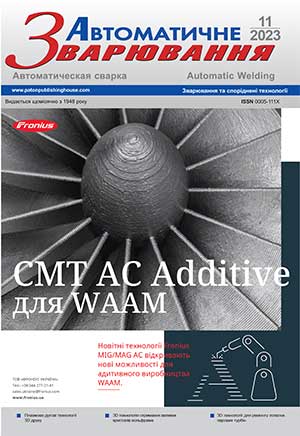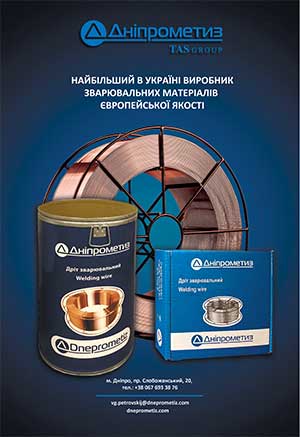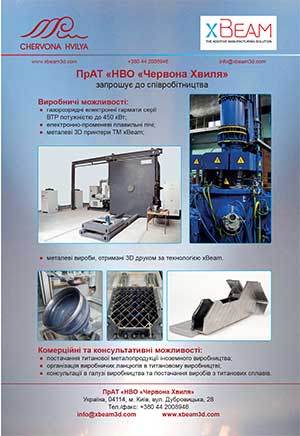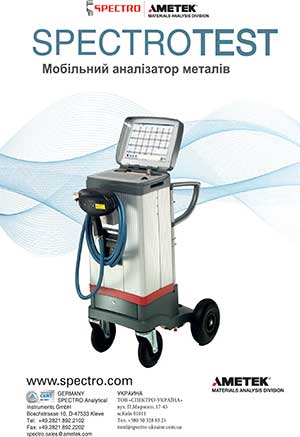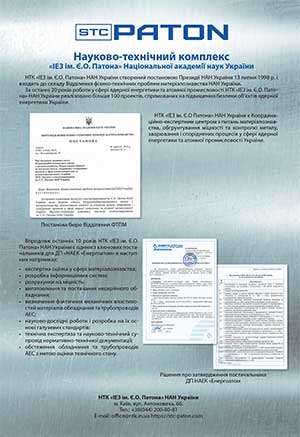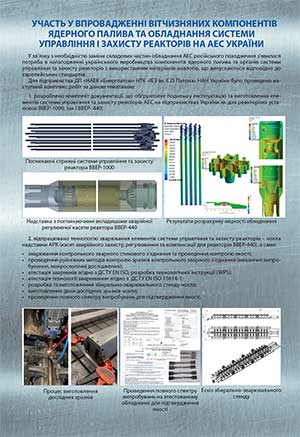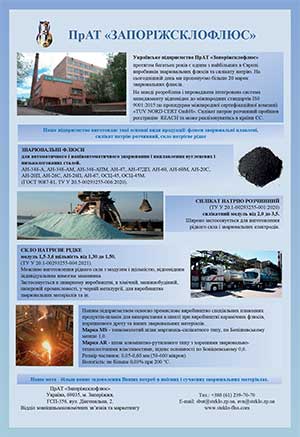| 2023 №11 (09) |
DOI of Article 10.37434/as2023.11.01 |
2023 №11 (02) |
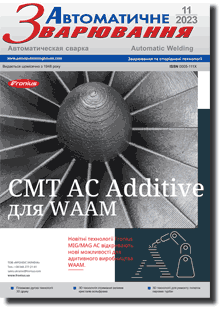
Журнал «Автоматичне зварювання», № 11, 2023, с. 5-22
Плазмово-дугові технології адитивного наплавлення (3D друку) просторових металевих виробів: досвід застосування і нові можливості
В.М. Коржик1, А.А. Гринюк1, В.Ю. Хаскін1, О.М. Войтенко1, О.М. Бурлаченко1, О.О. Хуан2,3
1ІЕЗ ім. Є.О. Патона НАН України. 03150, м. Київ, вул. Казимира Малевича, 11. E-mail: office@paton.kiev.ua2ІМЗ ім. Є.О. Патона, НТУУ «Київський політехнічний інститут імені Ігоря Сікорського». 03056, м. Київ, просп. Берестейський, 37. E-mail: olha_khuan@ukr.net
3Науково-дослідний інститут зварювальних технологій імені Патона в провінції Чжецзян. КНР, провінція Чжецзян, м. Ханчжоу, район Сяошань, вул. Шісін Беілу 857, оф. 426. E-mail: oliamir@163.com
Зростання актуальності 3D друку готових металевих виробів в останні роки обумовлене скороченням витрат на виготовлення, механічну обробку, зміну типорозмірів і номенклатури деталей, можливістю отримання суцільних деталей зі складною внутрішньої геометрією. Одним з найперспективніших процесів 3D друку, який забезпечує широкий діапазон продуктивності (0,02...25 кг/год. і більше) при можливості наплавлення стінки завтовшки 2...20 мм є адитивне плазмово-дугове наплавлення (АПДН) дротами та порошковими матеріалами. У роботі розглянуто сучасний стан досліджень адитивного виробництва металевих деталей зі сталей і сплавів, визначено стан і перспективи розвитку АПДН. Показано, що АПДН дозволяє виконувати 3D друк із використанням широкої номенклатури присаджувальних матеріалів, зокрема компактних і композиційних (порошкових) дротів, порошків легких сплавів і тугоплавких металів, композиційних порошків і механічних сумішей порошків сплавів, металокераміки, карбідів, боридів тощо. До нових можливостей застосування АПДН відносяться розробка технологій вирощування виробів із матеріалів з градієнтними функціональними властивостями, із різнорідних матеріалів, із супутнім модифікуванням наплавленого металу додатковою обробкою, покращенням властивостей наплавленого металу за рахунок застосування гібридних процесів. Висвітлено стан інноваційних розробок технологій та обладнання АПДН, виконаних в Інституті електрозварювання ім. Є.О. Патона НАН України, та їх промислового впровадження. Бібліогр. 32, табл. 5, рис. 22.
Ключові слова: адитивне виробництво, 3D друк, плазмово-дугове наплавлення, сталі, нікелеві, алюмінієві, титанові сплави, структура, механічні властивості, градієнтні функціональні властивості, обладнання
Надійшла до редакції 26.10.2023
Список літератури
1. Laue, R., Colditz, P., Möckel, M., Awiszus, B. (2022) Study on the milling of additive manufactured momponents. Metals, 12, 1167. DOI: https://doi.org/10.3390/met120711672. Antonysamy, A.A. (2012) Microstructure, texture and mechanical property evolution during additive manufacturing of Ti6Al4V alloy for aerospace applications: Microstructure. University of Manchester, faculty of Engineering and Physical Sciences.
3. Peleshenko, S., Korzhyk, V., Voitenko, O. et al. (2017) Analysis of the current state of additive welding technologies for manufacturing volume metallic products (review). Eastern European J. of Enterprise Technologies, 3/1(87), 42–52. DOI: https://doi.org/10.15587/1729-4061.2017.99666
4. Kvasnytskyi, V., Korzhyk, V., Lahodzinkyi, I. et al. (2020) Creation of volumetric products using additive arc cladding with compact and powder filler materials. Proceedings of the 2020 IEEE 10th International Conference on «Nanomaterials: Applications and Properties», 9–13 Nov, NAP 2020, 9309696. DOI: https://doi.org/10.1109/NAP51477.2020.9309696
5. Korzhik, V.N., Khaskin, V.Yu., Grinyuk, A.A. et al. (2016) 3D-printing of metallic volumetric parts of complex shape based on welding plasma-arc technologies (Review). The Paton Welding J., 5-6, 117–123. DOI: https://doi.org/10.15407/tpwj2016.06.20
6. Ge, J., Lin, J., Lei, Y., Fu, H. (2017) Location-related thermal history, microstructure, and mechanical properties of arc additively manufactured 2Cr13 steel using cold metal transfer welding. Materials Science & Engineering: A, 715, 144–153. DOI: https://doi.org/10.1016/j.msea.2017.12.076
7. Alberti, E.A., Bueno, B., D’Oliveira, A.S. (2015) Additive manufacturing using plasma transferred arc. The International J. of Advanced Manufacturing Technology, 83, 9–12. DOI: https://doi.org/10.1007/s00170-015-7697-7
8. Colegrove, P., Williams, S. (2013) High deposition rate high quality metal additive manufacture using wire + arc technology. Cranfield University. Режим доступу: URL: https:// www.xyzist.com/wp-content/uploads/2013/12/Paul-Colegrove-Cranfield-Additive-manufacturing.pdf
9. Özel, Т., Shokri, H., Loizeau, R. (2023) A review on wirefed directed energy deposition based metal additive manufacturing. J. Manuf. Mater. Process., 7(1), 45. DOI: https:// doi.org/10.3390/jmmp7010045
10. Korzhik, V.N., Vojtenko, A.N., Peleshenko, S.I. et al. (2017) Development of automated equipment for manufacturing 3D metal products based on additive technologies. The Paton Welding J., 5-6, 79–85. DOI: https://doi.org/10.15407/tpwj2017.06.15
11. Alhuzaim, A.F. (2014) Investigation in the use of plasma arc welding and alternative feedstock delivery method in additive manufacture: Master of Science General Engineering. Montana Tech. of the University of Montana.
12. Alaluss, K., Mayr, P. (2019) Additive manufacturing of complex components through 3D plasma metal deposition – A simulative approach. Metals, 9(5), 574. DOI: https://doi. org/10.3390/met9050574
13. Geng, H., Li, J., Xiong, J. et al. (2017) Geometric limitation and tensile properties of wire and arc additive manufacturing 5A06 aluminum alloy parts. J. of Materials Engineering and Performance, 26, 621–629. DOI: https://doi.org/10.1007/ s11665-016-2480-y
14. Gnatenko, M., Chigileichik, S., Sakhno, S. (2021) Manufacture of aviation parts from heat-related nickel alloys by multilayer plasma surfacing. Aerospace Technic and Technology, 5(175), 48–52. DOI: https://doi.org/10.32620/aktt.2021.5.06 [in Ukrainian]
15. Gnatenko, M., Zhemaniuk, P., Petrik, I. et al. (2019) Detecting the influence of heats sources on material properties when production a aviation parts by a direct energy deposition method. Eastern–European j. of enterprise technologies, 1(12(97)), 49–55. DOI: https://doi.org/10.15587/1729-4061.2019.157604
16. Gnatenko, M., Naumyk, V., Matkovska, M. (2019) Influence of sources of heating and protective gases on the properties of the material obtained by the direct deposition. Materials Science and Technology, 68–74. DOI: https://doi. org/10.7449/2019/MST_2019_68_74
17. Grinyuk, A.A., Korzhik, V.N., Shevchenko, V.E. et al. (2015) Main tendencies in development of plasma-arc welding of aluminium alloys. Тhe Paton Welding J., 11, 31–41. DOI: https://doi.org/10.15407/tpwj2015.11.04
18. Bai, J.Y., Yang, C.L., Lin, S.B. et al. (2016) Mechanical properties of 2219-Al components produced by additive manufacturing with TIG. Int. J. Adv. Manuf. Technol., 86, 479– 485. DOI: https://doi.org/10.1007/s00170-015-8168-x
19. Qi, Z., Cong, B., Qi, B. et al. (2018) Microstructure and mechanical properties of double-wire + arc additively manufactured Al– Cu–Mg alloys. J. of Materials Processing Technology, 255, 347– 353. DOI: https://doi.org/10.1016/j.jmatprotec.2017.12.019
20. Lin, Z., Song, K., Yu, X. (2021) A review on wire and arc additive manufacturing of titanium alloy. J. of Manufacturing Processes, 70, 24–45. DOI: https://doi.org/10.1016/j. jmapro.2021.08.018
21. Hoefer, K., Mayr, P. (2018) Additive manufacturing of titanium parts using 3D plasma metal deposition. Materials Science Forum, 941, 2137–2141. DOI: http://dx.doi. org/10.4028/www.scientific.net/MSF.941.2137
22. R´ıos, S., Colegrove, P.A., Williams, S.W. (2019) Metal transfer modes in plasma wire + arc additive manufacture. J. of Materials Processing Tech, 264, 45–54. DOI: https://doi. org/10.1016/j.jmatprotec.2018.08.043
23. Lin, J.J., Lv, Y.H., Liu, Y.X. et al. (2016) Microstructural evolution and mechanical properties of Ti–6Al–4V wall deposited by pulsed plasma arc additive manufacturing. Materials & Design, 102, 30–40. DOI: https://doi.org/10.1016/j. matdes.2016.04.018
24. Kelly, S.M., Kampe, S.L. (2004) Microstructural evolution in laser-deposited multilayer Ti–6Al–4V builds: Part II. Thermal Modeling. Metall Mater. Trans.: A, 35(6), 1869–1879. DOI: https://doi.org/10.1007/s11661-004-0095-7
25. Xu, F.J., Lv, Y.H., Xu, B.S., Liu, Y.X. (2013) Effect of deposition strategy on the microstructure and mechanical properties of Inconel 625 superalloy fabricated by pulsed plasma arc deposition. Mater., 45, 446–455. DOI: https://doi. org/10.1016/j.matdes.2012.07.013
26. Martinaa, F., Mehnen, J., Williams, S.W. et al. (2012) Investigation of the benefits of plasma deposition for the additive layer manufacture of Ti–6Al–4V. J. of Materials Processing Technology, 212(6), 1377–1386. DOI: https://doi. org/10.1016/j.jmatprotec.2012.02.002
27. Colegrove, P.A., Martina, F., Roy, M.J. et al. (2014) High pressure interpass rolling of wire + arc additively manufactured titanium components. Advanced Materials Research, 996, 694–700. DOI: https://doi.org/10.4028/www.scientific. net/AMR.996.694
28. Wu, B., Ding, D., Pan, Z. et al. (2017) Effects of heat accumulation on the arc characteristics and metal transfer behavior in wire arc additive manufacturing of Ti6Al4V. J. of Materials Processing Technology, 250, 304–312. DOI: http:// dx.doi.org/10.1016/j.jmatprotec.2017.07.037
29. Wua, B., Pana, Z., Dingb, D. et al. (2018) The effects of forced interpass cooling on the material properties of wire arc additively manufactured Ti6Al4V alloy. J. of Materials Processing Technology, 258, 97–105. DOI: https://doi. org/10.1016/j.jmatprotec.2018.03.024
30. Reisgen, U., Sharma, R., Oster, L. (2019) Plasma multiwire technology with alternating wire feed for tailor-made material properties in wire and arc additive manufacturing. Metals, 9(7), 745. DOI: https://doi.org/10.3390/met9070745
31. Qi, Z., Cong, B.Q., Qi, B. et al. (2018) Microstructure and mechanical properties of 1 double-wire + arc additively manufactured Al–2 Cu–Mg alloys. J. of Material Processing Technology, 255, 347–353. DOI: https://10.1016/j.jmatprotect.2017.12.019
32. Korzhyk, V.M., Grynyuk, A.A., Khaskin, V.Yu. et al. (2023) Influence of the speed of plasma-arc welding at a variable polarity asymmetrical current on the formation of joints of high-strength aluminium alloys. The Paton Welding J., 8, 17– 28. DOI: https://doi.org/10.37434/tpwj2023.08.02
Реклама в цьому номері:
Вартість передплати/замовлення на журнали або окремі статті
| журнал/валюта | річний комплект друкований |
1 прим. друкований |
1 прим. електронний |
одна стаття (pdf) |
| AS/UAH | 1800 грн. | 300 грн. | 300 грн. | 150 грн. |
| AS/USD | 192 $ | 32 $ | 26 $ | 13 $ |
| AS/EUR | 180 € | 30 € | 25 € | 12 € |
| TPWJ/UAH | 7200 грн. | 600 грн. | 600 грн. | 280 грн. |
| TPWJ/USD | 384 $ | 32 $ | 26 $ | 13 $ |
| TPWJ/EUR | 348 € | 29 € | 24 € | 12 € |
| SEM/UAH | 1200 грн. | 300 грн. | 300 грн. | 150 грн. |
| SEM/USD | 128 $ | 32 $ | 26 $ | 13 $ |
| SEM/EUR | 120 € | 30 € | 25 € | 12 € |
| TDNK/UAH | 1200 грн. | 300 грн. | 300 грн. | 150 грн. |
| TDNK/USD | 128 $ | 32 $ | 26 $ | 13 $ |
| TDNK/EUR | 120 € | 30 € | 25 € | 12 € |
AS = «Автоматичне зварювання» - 6 накладів на рік;
TPWJ = «PATON WELDING JOURNAL» - 12 накладів на рік;
SEM = «Сучасна електрометалургія» - 4 наклада на рік;
TDNK = «Технічна діагностика та неруйнівний контроль» - 4 наклада на рік.






